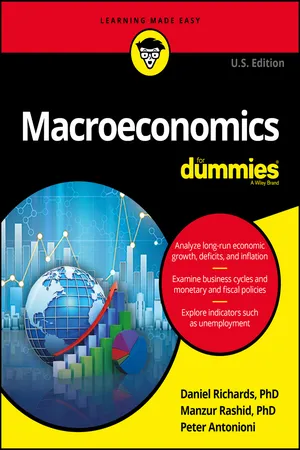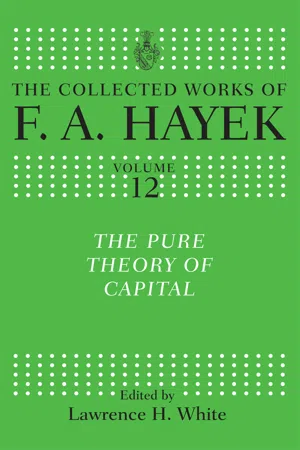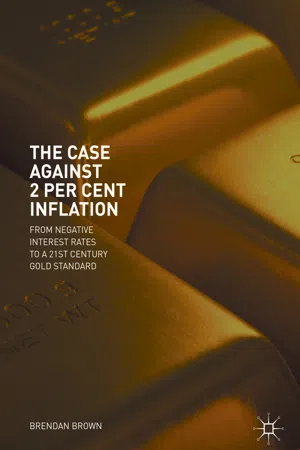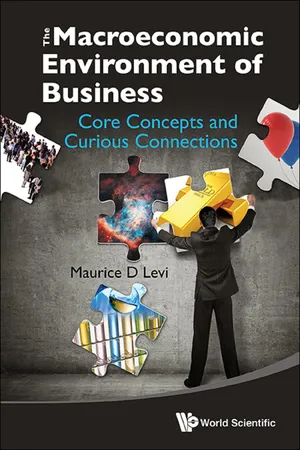Economics
Long Run Interest Rate
The long run interest rate refers to the equilibrium level of interest rates in an economy over an extended period. It is influenced by factors such as inflation expectations, productivity growth, and the overall health of the economy. In the long run, interest rates tend to reflect the real rate of return on investments and the rate of inflation.
Written by Perlego with AI-assistance
Related key terms
5 Key excerpts on "Long Run Interest Rate"
- eBook - ePub
- Jagdish Handa(Author)
- 2002(Publication Date)
- Routledge(Publisher)
The traditional (pre-Keynes) classical economists simplified their analysis of the credit market by ignoring financial intermediaries completely and assuming that governments do not incur deficits or surpluses. Under these assumptions, they formulated both a long-run and a short-run theory of interest, the former with equilibrium in the money market and the latter without it. In their long-run theory of interest, the flow demand for new loans was solely for investment purposes and the net increase in the supply of loanable funds was solely from new saving. Since full employment was an implication of their ideas on the labour market and became an assumption in their analysis of the credit market, this saving equalled the amount coming forth from full employment income. Hence, the rate of interest that would be determined by the long-run supply and demand for loanable funds in any period would be the same rate of interest as that determined by the equality of full employment saving and investment.The traditional classical economists specified the fundamental determinant of saving as the public’s ‘time preference’ – that is, a preference for present over future consumption.4 They argued that people would only save – that is, postpone consumption – if induced to do so by a positive rate of interest. Thus, at an r % annual rate of interest, postponing consumption by $1 enables a saving of $1 which enables consumption next year of $(1 + r ). The higher the rate of interest, the greater is the inducement to postpone consumption, so that saving is positively related to the rate of interest.5 Note that in this analysis, the dependence of saving on income tended to be ignored since national income was assumed by the traditional classical economists to be at the full employment level in the long run.The traditional classical economists specified the corresponding fundamental determinant of the demand for funds as arising from and being equal to investment. Such demand depends upon the productivity of investment which, in turn, depends upon the state of technical knowledge, the existing stock of capital and employment. The traditional classical economists equated investment to the change in the desired capital stock and determined the latter from the profit-maximizing condition that the marginal product of capital equal the real interest. - eBook - ePub
- Dan Richards, Manzur Rashid, Peter Antonioni(Authors)
- 2016(Publication Date)
- For Dummies(Publisher)
Part 3The Long-Run Macro Economy
IN THIS PART … Understand the importance of economic growth and the determination of the economy’s long-run growth path. Discover that in the long run, inflation is determined by money growth. Discover that in the long run, real interest rates primarily reflect households’ willingness to save.Passage contains an image Chapter 8
GDP Growth in the Long Run
IN THIS CHAPTER Compounding growth: The rule of 70 Marginalizing firm decisions Growing GDP over time Steadying the stateWe’ve said it before and we’ll say it again: Economists love models. Building an economic model and considering its implications forces you to think hard about which assumptions lead to which results and whether those assumptions make sense. And it’s only after you have a model that you can begin to test it with evidence.Some of the time, or maybe most of the time, economists disagree at one or more of these stages. They argue over assumptions. They argue over the empirical evidence. They argue over arguing. But in macroeconomics, one area where economists don’t argue too much is about the nature of the long run. There is a lot of agreement about the economy’s long-run behavior and which macroeconomic policies will promote a healthy long-run growth path.That long-run path is an anchor — a full equilibrium. It is in fact the potential output described in Chapter 3 , because it reflects full employment of the economy’s capital and labor resources. Whatever happens in the short run, there are forces (sometimes weak but always present) that pull the economy back toward that potential. Put somewhat differently, recessions can cause the economy to drift away from its long-run equilibrium for some time and by a significant amount. But ultimately the economy always returns to that long run, full-employment path.In this chapter, you’ll hear about the long-run growth model that most macroeconomists think works for modern economies like the U.S. You’ll also get an idea of the critical but complicated role that society’s willingness to save plays in that model — and what the long-run equilibrium says about interest rates and the price of credit as well. - eBook - ePub
- F. A. Hayek, Lawrence H. White, Lawrence H. White(Authors)
- 2019(Publication Date)
- Routledge(Publisher)
Part IV The Rate of Interest in a Money EconomyPassage contains an image Twenty-Six Factors Affecting the Rate of Interest in the Short Run
The ‘Rate of Interest’ in Equilibrium Analysis and the Money Rate of InterestThe task of the first three Parts of this book has been to show, by the same general method as is used by equilibrium analysis to explain the prices of different commodities at a given moment, why there will be certain differences between the prices of the factors of production and the expected prices of the products, and why these differences will stand in a certain uniform relationship to the time intervals which separate the dates when these prices are paid. In conformity with an old-established practice, we have described these price differ-ences, which can be expressed in terms of a time rate, as the rate of interest. But, as we have warned the reader early in this book, this ‘rate of interest’ is not identical with the price for money loans to which this term is applied in a money economy. It is not a price paid for any particular thing, but a rate of differences between prices which pervades the whole price structure. Insofar as the money rate of interest is concerned, our rate of interest is merely one of the factors which helps to determine it, and is the phenomenon most nearly corresponding to it which we can find in our imaginary moneyless economy. But if it were not for the well-established usage, it would probably have been better to refer to this ‘real’ phenomenon either, as the English classical economists did, as the rate of profit, or by some such term as the German Urzins.1 - eBook - ePub
The Case Against 2 Per Cent Inflation
From Negative Interest Rates to a 21st Century Gold Standard
- Brendan Brown(Author)
- 2018(Publication Date)
- Palgrave Macmillan(Publisher)
in this environment would be determined in aggregate by the mass of individual borrowing and lending decisions, project by project, firm by firm, household by household, and so draw together a huge range of decentralized information. For example, a business taking today’s long-term interest rate would decide whether a particular project had positive net present value. In effect that decision is taken on the basis of equity capital market pricing for many firms, but often there is no direct quote on this—as would be the case if each project is to be considered one by one (and publicly available equity price is based on all projects present and potential bundled together). Instead the decision-maker proceeds (in capital budgeting) by taking the quoted long-term rate and adding an assumed equity risk premium. And there are areas of the economy in which there are no relevant equity capital costs to determine decision-making—for example, housing and consumer spending—though there are a range of possible “wealth effects” related to equity market performance. Yes, there would be speculative position-taking by those judging long-term rate trends based on macro-economic assessments including the path of the business cycle, but these would not take their cue from the volatile path of short-term interest rates.By construction, the long-term rates determined as above would be closer on average to hypothetical neutral level (meaning consistent with sound money) than those dominated by the monetary acrobatics of the central bank. Also those transacting in the long-term rate markets would have greater confidence that the price there is indeed anchored in reality rather than just the result of frenzied speculation or desperation. The chances of the economy going a long way into serious disequilibrium accompanied by delirious asset prices and huge mal-investment are surely less under a monetary regime where the long-term rate markets are signalling appropriately a mass of decentralized information about micro-economic conditions than the opinions of the leading monetary bureaucrat and his or her political master. And of course equity markets, in taking their cue from mispriced bond markets, especially in an environment of income famine - eBook - ePub
The Macroeconomic Environment of Business
Core Concepts and Curious Connections
- Maurice D Levi(Author)
- 2014(Publication Date)
- WSPC(Publisher)
CHAPTER 7 INTEREST RATES“Gentlemen prefer bonds”Andrew MellonKey Concepts: Interest rates and the supply of loanable funds; interest rates and the demand for loanable funds; the equilibrium interest rate; the market versus equilibrium interest rate; monetary policy and interest rates; real growth and interest rates; anticipated inflation and interest rates; real versus nominal interest rates; fiscal deficits, crowding-out and interest rates; international capital flows and interest rates.THE INTEREST IN INTEREST RATESInterest rates have a substantial effect on borrowing and spending decisions of businesses and consumers, and thereby on employment, GDP, and other measures of macroeconomic activity. For example, as we shall see, interest rates influence the willingness of businesses to invest in new plant and equipment, and in turn, the current and future size of the GDP.At the same time that interest rates affect the economy, the economy affects interest rates. This occurs as a result of the effects that national income, inflation and confidence about the future have on the willingness of consumers and businesses to borrow and invest, and hence on the price of borrowing, which is the interest rate. With the direction of flow being in both directions, from interest rates to the economy and from the economy to interest rates, in order to explain interest rates we need a theory that captures this two-way flow of influence. Such a theory is the loanable funds theory. While there are numerous other theories of interest rates, the loanable funds theory embraces many aspects of these other theories, and therefore serves as an ideal window onto the world of interest rates.LOANABLE FUNDS THEORY OF INTERESTAccording to the loanable funds theory, interest rates are determined by the supply of and demand for loanable funds, which can be thought of as monies that can be lent and borrowed. Therefore, in order to explain this theory, we must begin by considering loanable funds supply and demand.
Index pages curate the most relevant extracts from our library of academic textbooks. They’ve been created using an in-house natural language model (NLM), each adding context and meaning to key research topics.




